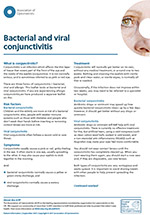Bacterial and viral conjunctivitis
Inflammation of the front of the eye and eyelids caused by an infection
What is conjunctivitis?
Conjunctivitis is an infection which affects the thin layer of tissue that covers part of the front of the eye and the inside of the eyelids (conjunctiva). It is not normally serious, and is sometimes referred to as pink or red eye.
There are three forms of conjunctivitis – bacterial, viral and allergic. This leaflet looks at bacterial and viral conjunctivitis. If you are experiencing allergic conjunctivitis, we have produced a separate leaflet on this.
Risk factors
Bacterial conjunctivitis
Children and the elderly are more at risk of a bacterial conjunctivitis. Also, people with weaker immune systems such as those with diabetes and people who don’t wash their hands before inserting or removing contact lenses are more at risk.
Viral conjunctivitis
Viral conjunctivitis often follows a recent cold or sore throat.
Symptoms
Conjunctivitis usually causes a pink or red, gritty-feeling in the eye. It often starts in one eye, usually spreading to the other. It may also cause your eyelids to stick together in the morning.
And:
- Bacterial conjunctivitis normally causes a yellow or green sticky discharge
- Viral conjunctivitis normally causes a watery discharge
Treatment
Conjunctivitis will normally get better on its own, without any medical treatment, in around one to two weeks. Bathing and cleaning the eyelids with sterile pads and clean water, or sterile wipes, is normally all that is needed.
Occasionally, if the infection does not improve within two weeks, you may need to be referred to a specialist or hospital.
Bacterial conjunctivitis
Antibiotic drops or ointment may speed up how quickly bacterial conjunctivitis clears up by a few days. However, it should get better without any drops or ointment.
Viral conjunctivitis
Antibiotic drops or ointment will not help with viral conjunctivitis. There is currently no effective treatment for this, but artificial tears, using a cold compress (such as clean cotton wool balls soaked in cold water), and a non-steroidal anti-inflammatory (NSAID) such as Ibuprofen may make your eyes feel more comfortable.
You should not wear contact lenses until the conjunctivitis has completely cleared up. When you start wearing them again, you should start a new case and, if they are disposalble, with new lenses.
Both types of conjunctivitis are very contagious and easily spread. It is important to avoid sharing towels with other people to help prevent spreading the infection.
The NHS says that you don't need to stay away from work or school if you have conjunctivitis, unless you are feeling particularly unwell. However, if you work in close contact with others, or share equipment such as phones and computers, you shouldn't return to work until the discharge has cleared up. If there are a number of cases of conjunctivitis at your child's school or nursery, you may be advised to keep them away until the infection has cleared up.
Treatment method
- Wash your hands before and after cleaning your eyelids
- Rub the moistened pad or cotton wool ball firmly but gently along the eyelid edges to remove the crusts
- Take care to wipe between the eyelashes of both the upper and lower lids
- Use a fresh pad or wipe each time and do not use the same pad for the other eye as this may spread the infection
- Dry your eyes gently. Do not let anyone else use your towel
Resources for your practice

You can download our patient leaflet on bacterial and viral conjunctivitis.
If you're a practitioner, we recommend that you use this information, following a suitable examination, to reinforce advice given to the patient who has symptoms of bacterial or viral conjunctivitis.
For more information on eye health, go to our For patients section.

